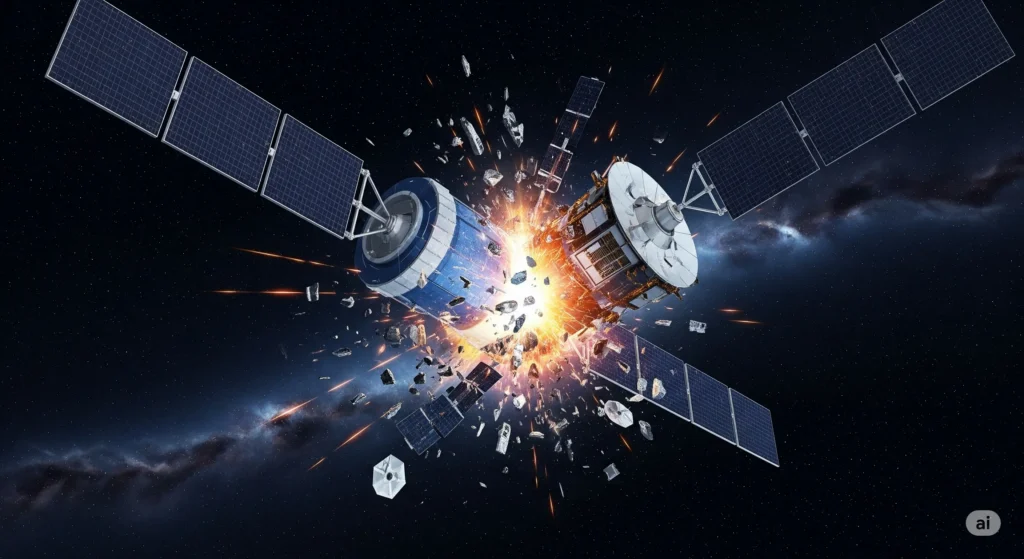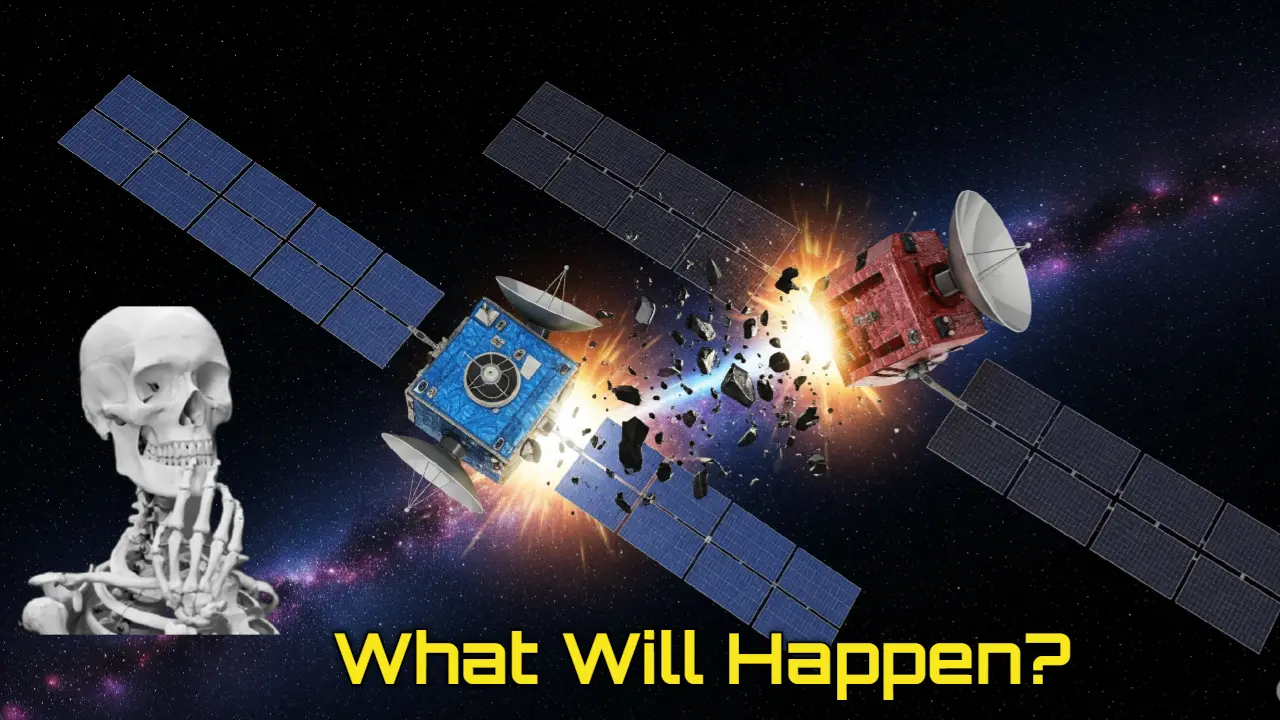Space is vast—but not empty. With thousands of satellites, rockets, and debris hurtling around Earth at mind‑blowing speeds, collisions—though rare—do happen. So let’s dive into the chaotic, cosmic “car crash” of spacecraft and see what really goes down when two machines meet at orbital velocity as (spacecraft collision).
What Speeds Are We Talking About?
Most orbital objects race around Earth at 7–8 km/s (about 25,000–30,000 mph). At those speeds:
- A Spacecraft collision doesn’t cause a bump or dent—it’s an explosion.
- The objects penetrate each other before shock waves can react, shredding into countless fragments that scatter like confetti
This kind of high-speed “hypervelocity collision” is far more violent than anything we experience on Earth—tiny bits of debris moving at 3,000 mph can punch through a spacecraft panel!
When It’s Real: Past Spacecraft Collisions in History
On February 10, 2009, an active Iridium satellite and a defunct Russian craft called Cosmos 2251 smashed in low Earth orbit at ~11.7 km/s. The result?
- Total destruction of both spacecraft.
- Creation of thousands of debris fragments still tracked today.
- A clean demonstration of active satellites colliding.
Cerise and Ariane Debris (1996)
The French satellite Cerise was blindsided by debris from an old Ariane rocket, tearing off part of its stabilization arm. Though it survived and recovered, damage was serious
These events underscore how even small debris—unavoidable in orbit—can cause major trouble.
Why Collision = Explosion (Not Bump)

In hypervelocity collisions:
- Objects interpenetrate, shock waves fragment them before they even “see” each other
- The result: hundreds or thousands of fragments, each on a new trajectory.
- The fragment sizes range widely—from tiny chips to large chunks.
Breakup Energy Thresholds:
A 0.5 kg piece hitting at 10 km/s (≈ 40 J/g) often shatters an entire spacecraft into debris. Think of a bullet blowing apart a glass bottle—but at cosmic scale and speed.
The Domino Effect: Kessler Syndrome
Named after NASA scientist Donald Kessler (1978), this frightening scenario says:
- One collision makes debris.
- Debris hits other satellites.
- More debris follows, leading to a runaway chain reaction.
- Eventually, key orbital corridors become unusable
NASA models suggest LEO is teetering on that tipping point—if we don’t act, space itself could become jammed with junk
What About Spacecraft Crashing on Purpose?

This isn’t hypothetical fiction—it’s a real technique.
NASA’s DART Mission (2022):
They deliberately crashed into asteroid Dimorphos at 6 km/s, 610 kg mass—shifting the asteroid’s orbit, but barely scratching it
What does this tell us?
- Kinetic impacts of spacecraft onto large bodies are almost negligible for them.
- Such tactics can defend Earth from dangerous asteroids.
- Still, they generate debris—NASA observed clusters of rocky ejecta tens of feet wide
That debris might be harmless now, but could create future meteor showers—even reach Mars in thousands of years
What Actually Happens If Two Spacecraft Accidentally Collide? Mean “what happens if spacecraft collide.”
Immediate Aftermath
If two active spacecraft collide:
- They explode into hundreds or thousands of fragments.
- Each fragment becomes its own mini-satellite, speeding off on a new trajectory.
- Some fragments may continue to orbit for decades or even centuries
Collision Cascade Risk
These fragments may collide with other assets, creating massive debris clouds—a scenario straight out of the movie Gravity. It’s the Kessler chain reaction in motion.
Long-Term Hazard
Debris remains in orbit until atmospheric drag brings it down—can be decades in LEO, centuries in higher orbits. In GEO, it just hangs around unless actively removed.
Also Read:
NASA’S ARTEMIS MISSION: THE BEGINNING OF A NEW SPACE AGE.
How Space Agencies Try to Prevent Collisions
Orbit Tracking:
- Major players track satellites and debris globally.
- Thousands of conjunction “warnings” are issued—e.g., SpaceX performed ~50,000 Starlink avoidance maneuvers in early 2024
Avoidance Manoeuvres:
- If a close approach is flagged, satellites (especially active ones) can shift orbit minutes ahead—using fuel but avoiding smashups.
Regulations:
- Defunct satellites must de-orbit within 5 years (ESA policy)
Shielding:
Spacecraft often feature Whipple shields to absorb impacts, but bigger fragments easily penetrate
Debris Cleanup R&D:
ESA and others are testing nets, harpoons, lasers to remove junk
The Human Side: Space Crash Liability & Politics
- If two nations’ satellites collide, who’s responsible?
→ It’s murky under international law
- For accidental collisions, usually, no compensation is paid – just tracking and legal wrangling.
- For deliberate anti‑satellite tests, global condemnation often follows—but debris keeps floating.
What Happens to a Spacecraft Fragment That Heads Toward Earth?
Most debris burns up in the atmosphere. But bigger fragments may survive:
- The Hayabusa re-entry fragments disintegrated above 47 km—only capsule survived
- Space station parts (like MIR) have been guided to re-enter over the ocean to prevent damage
So, you’re unlikely to find a chunk on your lawn—but not impossible.
Should We Worry?
- Rare? Yes—only one major accidental collision between intact satellites has happened so far.
- But… as low-Earth orbit gets crowded, the risk is growing fast.
- What if two big ones collided tomorrow? → Likely: Explosion → debris storm → costly evasion for other satellites → long-term hazard.
- What if a human starship collided? → If there were crew onboard—catastrophic. Immediate loss, no shield can protect from orbital impacts.
So What Will Happen?
| Scenario | Immediate Effect | Long-Term Impact |
|---|---|---|
| Two satellites collide | Explosive breakup, thousands of fragments | Increased debris risk—possible Kessler cascade |
| Intentional spacecraft vs asteroid | Minimal change to asteroid, lots of ejecta | Useful for asteroid defense but adds debris |
| Space station accident (e.g., Mir) | Partial damage, possible maneuvering | Controlled deorbit mitigates surface risk |
| Uncontrolled large object re-entry | Fragments burn, some reach Earth | Low but finite risk to people/property |
Final Thoughts:
- Space collisions are dramatic, explosive, and unpredictable.
- As more satellites launch, the danger of cascade collisions rises.
- Vigilant tracking, avoidance, clean-up, and international cooperation are essential.
- Every collision—intentional or accidental—teaches us valuable lessons for space safety.
So yes, next time you glance at the sky and think about all those satellites, remember: they’re dancing at blistering speeds. And if even two of them collide—it’s no ordinary fender-bender. It’s cosmic chaos. Stay curious, stay safe, and keep watching the skies!
